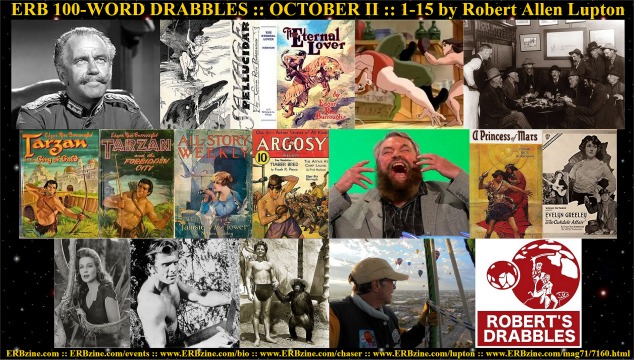
Official Edgar Rice Burroughs Tribute and Weekly Webzine Site Since 1996 ~ Over 15,000 Webpages in Archive Volume 7160 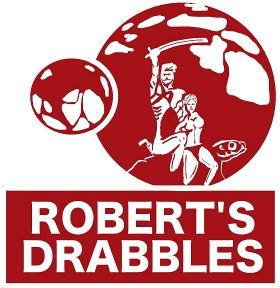 |
ERB 100-Word Drabbles
OCTOBER II Edition :: Days 1 - 15
See Days 16 - 31 at ERBzine 7160a
by Robert Allen Lupton
With Collations, Web Page Layout and ERBzine Illustrations and References by Bill Hillman
I LOVE YOUR BOOK
October 1: On this day in 2006, Actor Alan Caillou died in Sedona Arizona. He had a reoccurring role on the Ron Ely Tarzan series, playing a character named Jason Flood.
Englishman Alan Lyle-Smythe was born in 1914. The future film and TV writer-actor trained as an actor before serving for four years with the Palestine Police in the 1930s. At the outbreak of World War II, he joined the British Army; part of their Intelligence Corps, he operated behind enemy lines in Libya and Tunisia. He was captured in North Africa imprisoned and threatened with execution in Italy, then escaped to join the British forces at Salerno.He wrote about his experiences in the book “The World is Six Feet Square”. He was promoted to captain and awarded the Military Cross in 1944.
Following the war, he returned to the Palestine Police from 1946 to 1947. He wrote about this experience in the book “Sheba Slept Here.”
He appeared as an actor and/or worked as a screenwriter in such shows as “Daktari”, “The Man From U.N.C.L.E.” (including the screenwriting for "The Bow-Wow Affair" from 1965), “Thriller,” “Daniel Boone,” “Quark,” “Centennial,” and “How the West Was Won.” In 1966, he had a recurring role in NBC's "Tarzan" TV series starring Ron Ely.
His cinema film credits included roles in “Five Weeks in a Balloon” (1962), “Clarence, the Cross-Eyed Lion “(1965), “The Rare Breed” (1966), “The Devil's Brigade” (1968), “Hellfighters” (1968), “Everything You Always Wanted to Know About Sex* (*But Were Afraid to Ask)” (1972), “Herbie Goes to Monte Carlo” (1977), “Beyond Evil” (1980), “The Sword and the Sorcerer” (1982) and “The Ice Pirates” (1984).
Caillou wrote 52 paperback thrillers under his own name and the nom de plume of Alex Webb, with such heroes as Cabot Cain, Colonel Matthew Tobin, Mike Benasque, Ian Quayle and Josh Dekker, as well as writing many magazine stories. He also wrote books under female names. Several of Caillou's novels were filmed, such as “Rampage” with Robert Mitchum in 1963.
“I Love Your Book” is the drabble for today.
I LOVE YOUR BOOK
![]()
“Yes, I talked my way out.”
“How?”
“The Lieutenant recognized me from one of my paperback books, “Angelina Ricci in Constantinople.” Angelina, descended from Lucrecia Borgia, was an Italian spy during WW1. I used the name, Raffaele Romano.”
“I read a chapter to the men daily. Please sign our
book?”
I nodded and he untied me. We had wine and cheese.
I promised to put them in a book. I put them in “Sheba Slept Here.”
“Is that true?”
Alan winked, “Sheba slept everywhere.”
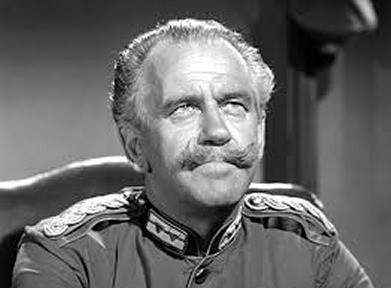
HEY, BABY
October 2: On this day in 1944, Edgar Rice Burroughs began writing “Savage Pellucidar,” the fourth installment of the novel, “Savage Pellucidar.” The first three parts were “Return to Pellucidar,” “Men of the Bronze Age,” and “Tiger Girl.”
“Savage Pellucidar, the short story,” was first published 21 years after the publication of “Tiger Girl” in “Amazing” November 1963 with cover and two interior illustrations by Larry Ivie. Canaveral Press published the first edition of the book, encompassing all four parts on November 25, 1963 with a cover by J. Allen St. John.
For more publishing details, cover art and interior art:
HEY, BABY
![]()
Hodon was washed overboard, but survived.
Each believed the other dead, and they faced countless perils until they met again near the Land of Awful Shadow. Hodon said, “David taught me a song from his world, “You so pretty, you so fine. O-aa, O-aa, hey baby, I wanna know if you’ll be my girl.”
O-aa laughed and kissed him.
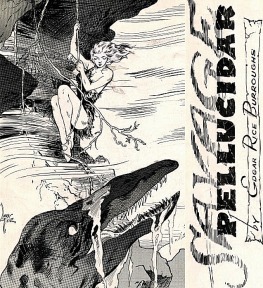
QUIRK IN TIME
October 3: On this day in 1925, A. C. McClurg published the first edition of “The Eternal Lover.” The 316 page book had a J. Allen St. John dust jacket and a print run of 5000 copies. Grosset and Dunlap reprinted the book in 1927 and 1940. Ace Books retitled the book, “The Eternal Savage” and published it in 1963 with a Roy Krenkel cover. It was reprinted by Ace with a cover by Frank Frazetta.
One of my favorite things about this book is it is one of Edgar Rice Burroughs’ few crossover stories. Tarzan, Jane, and Victoria Custer, the sister of Barney Custer from “The Mad King,” are featured in the story.
For more publishing information and numerous cover illustrations, foreign and domestic, visit.
QUIRK IN TIME
![]()
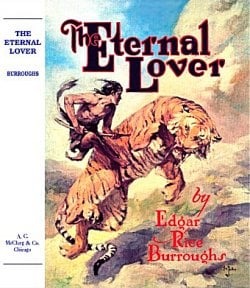
TAKING A PUNCH
October 4: On this day in 2001, Disney’s television series, “The Legend of Tarzan,” aired episode 28 of season 1, “Tarzan and One Punch Mullargan.” Two well-known actors voiced characters in this episode, Bruce Campbell voiced Max Leibling and Rene Auberjonois voiced Renard Dumont.
The arrogant and aggressive Heavyweight Boxing Champion "One Punch" Mulligan, along with his manager and personal journalist, visited the jungle while on a safari. When Tarzan accidentally knocks "One Punch" out cold, the boxer demands a rematch. Tarzan refuses; however, "One Punch" is stubborn and finds a way to provoke Tarzan into a fight.
Rene played the original Father Mulcahy (Dago Red) in M*A*S*H, the movie. He made hundreds of television appearances, did voices for dozens of animation features, and appeared in numerous films. He is probably best known as ODO in “Star Trek Deep Space Nine” and Clayton Edicott in “Benson.”
Bruce Campbell is best known for playing Ash Williams in the “Evil Dead” movies, Sam Axe in “Burn Notice,” and my favorite, “Elvis Presley,” in “Bubba Ho-Tep.”
Today’s drabble, “Taking a Punch,” is inspired by Edgar Rice Burroughs.
TAKING A PUNCH
![]()
Tarzan said, “Welcome to Africa. Everyone is welcome who respects the jungle.”
Mullargan held up his fist. “Respect this. Put up your dukes, jungle boy.”
“Tarzan chooses not to engage in foolish fisticuffs.”
“Fisticuffs? Pretty fancy talk.” Mullargan threw a big right hand.
Tarzan ducked the blow and countered with a right cross and an uppercut, knocking Mullargan out.
Mullargan came too. “I thought you didn’t box.”
“Said I chose not to box. I never said I didn’t know how.
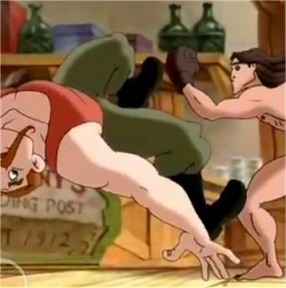
TO ROB OR NOT TO ROB
October 5: On this day in 1912, Edgar Rice Burroughs submitted the 3,500 western short story, “For the Fool’s Mother,” to Story-Press Corporation. The story was not accepted. Burroughs revised the story as a film synopsis (The Prospector) in October of 1915. The synopsis was never accepted.
The two main characters in the story are an unnamed prospector and ‘Kid’ Turner. Texas Pete makes a brief appearance. The story was published in the book, “Forgotten Tales of Love and Murder,” by Guidry and Adkins in 2001.
The entire story may be read online at the following link:
TO ROB OR NOT TO ROB
![]()
Penwell soon won all the ‘Kid’s’ money, but Turner
discovered he’d been cheated and shot the gambler.
“He cheated and won all my money. Now they’ll hang
me.”
‘Only if they catch you,” said the prospector. He
frisked Penwell and shoved all the cash into Turner’s hat. “Out the back
door. I’ll delay the sheriff. Remember, money ain’t won until you walk
out the door with it.”
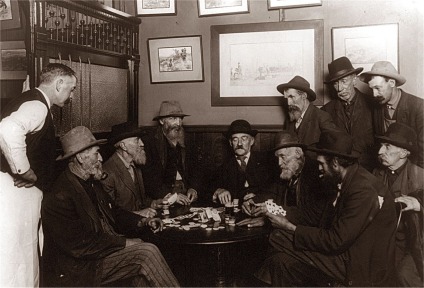
SO MANY VERSIONS
October 6: On this day in 1952, Whitman released authorized and abridged versions of "Tarzan and the City of Gold" and “Tarzan and the Forbidden City.”
The front and back covers of “Tarzan and the City of Gold” and “Tarzan and the Forbidden City were drawn by Don McLoughlin. Jesse Marsh illustrations were used for the endpapers, title page and several blue tinted interior drawings. I haven’t been able to find anything about Don McLoughlin, except that he drew these two covers.
The drabble for today, “So many Versions,’ was inspired by Edgar Rice Burroughs and the many versions of “Tarzan and the Forbidden City.”
SO MANY VERSIONS
![]()
Pat laughed, ‘Not for ‘Forbidden City. It started as a radio serial, “Tarzan and the Diamond of Asher, “written by Rob Thompson. Burroughs revised it as “The Red Star of Tarzan” for Argosy Weekly” and then again for his twentieth Tarzan novel, “Tarzan and the Forbidden City.” Who’s to say which the true version is?”
“I believe the first edition is “The Version.”
‘John, I think of the pulp version as the true version.”
“Think what you like. It’s not forbidden.”
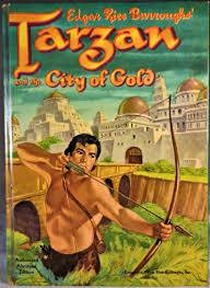
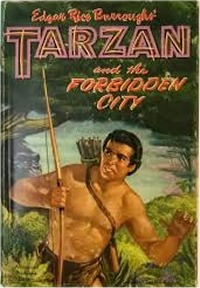
I KNOW IT WHEN I SEE IT
October 7: On this day in 1916, All-Story Weekly published part three of four of “The Girl From Farris’s.” The cover of the magazine illustrated the story, “Tamsie of the Tower,” by Nalbro Bartley. I haven’t identified the artist. Nalbro Isaadorah Bartley was an American short story writer, newspaper columnist and lecturer. Her serialized stories began appearing in popular magazines of the day while she was still in her early twenties. At least seven of her novels and stories were adapted to the movie screen between 1918 and 1932 including “Head Over Heels” and “Amateur Wife.”
For publishing details and several illustrations visit: October 7, 2020 and on this day in 1916, All-Story Weekly published part three of four of “The Girl From Farris’s.” The cover of the magazine illustrated the story, “Tamsie of the Tower,” by Nalbro Bartley. I haven’t identified the artist.
Nalbro Isadorah Bartley was an American short story writer, newspaper columnist and lecturer. Her serialized stories began appearing in popular magazines of the day while she was still in her early twenties. At least seven of her novels and stories were adapted to the movie screen between 1918 and 1932 including “Head Over Heels” and “Amateur Wife.”
For publishing details and several illustrations of "The Girl From Farris's" visit https://www.erbzine.com/mag7/0761.html
The drabble today, “I Know It When I See It,” was inspired by Edgar Rice Burroughs.
I KNOW IT WHEN I SEE IT
![]()
Maggie replied. “All you’ve seen me do is slide down a drainpipe. I didn’t take money from the drainpipe – how is that prostitution?”
“I saw you inside Farris’s. That means you’re a prostitute, pure and simple.”
“So everyone inside a brothel is a prostitute? Seriously, if you saw me, then you were in Farris’s yourself. Using the same logic, what does that make you?”
“Don’t be clever.”
“Wait I know. I saw you hiding behind a mounted policeman.
I guess that makes you a horse’s ass.
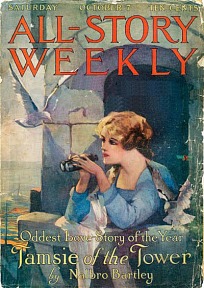
I WRITE TO GET PAID
October 8: On this day in 1932, Argosy Weekly published part four of six installments of “Pirates of Venus.”
Paul Stahr drew the cover for the first installment and Samuel Cahan drew one black and white illustration for each issue. The cover illustration for the October 8, 1932 issue had nothing to do with Burroughs or Pirates of Venus. “Edgar Rice Burroughs” does appear on the cover, but there is no mention of the ERB story contained within. The cover illustration is for the story “Timber Bred,” by Frank R. Pierce.
Pierce was primarily remembered for his westerns, although he wrote a number of air adventure stories. Born in Greenfield, Massachusetts, Pierce became one of America’s most prolific writers. His career spanned nearly fifty years. He produced over 1500 short stories, three novels and four feature films. Over 1000 of his stories were published in Argosy or the Saturday Evening Post.
Rumors have persisted that Burroughs wrote the first Venus stories to punish Otis Adelbert Kline for writing books that took place on Mars. Several internet articles touch on the ‘rivalry,’ but no compelling evidence is ever presented.
The drabble for today, ‘I write to Get Paid,’ is inspired by those rumors.
I WRITE TO GET PAID
![]()
‘Of course I didn’t. Mercury’s too hot, and the other planets are too big. Venus seemed just right.”
“So Kline had nothing to do with it?”
“No, and I didn’t write “The Bandit of Hell’s Bend” because of Zane Grey, or “The Mad King” because of Anthony Hope. No time for games, I write to get paid.”
“Did you write The
Moon Maid because of Jules Verne?”
“No, but I’m about to write a mystery about a newspaperman
murdered by a writer.”
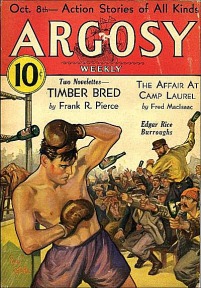
VOCAL TRAINING
October 9: On this day in 1936, British actor, Brian Blessed was born. He voiced the villainous William Clayton, an intelligent and suave - yet arrogant and treacherous - hunter, who guides the Porters on their quest.in Disney’s 1999 “Tarzan.” While actor, Tony Goldwyn voiced Tarzan in the movie, Brian Blessed provided the Tarzan yell.
Blessed’s filmography and acting credits are endless. To name a few, Porthos in the BBC production of “The Three Musketeers,” “The Avengers,” “I, Claudius,” “Return to Treasure Island,” and “Robin Hood, Prince of Thieves.” He appeared in the original West End Theatre production of ‘Cats,’ playing Old Deuteronomy and Bustopher Jones. He appeared in 4 of 5 of Kenneth Branaugh’s Shakespeare films, playing the Duke of Exeter in Henry V. The man was awesome.
He was not only an actor. The man was well chosen to voice an adventurer. In real life, Blessed attempted to climb Mount Everest times without supplemental oxygen, reaching heights of 28,200 feet (8,600 m) in 1993 and 25,200 feet (7,700 m) in 1996, but without reaching the summit. He has reached the tops of Mount Aconcagua and Mount Kilmanjaro in Tanzania. He is the oldest man to go to the Magnetic North Pole on foot, and has undertaken an expedition into the jungles of Venezuela during which he survived a plane crash.
Blessed holds a 3rd degree black belt in Judo. Blessed has completed 800 hours of space training at Star City in Russia. Blessed participated as a master of ceremonies at the British farewell ceremony marking the handover of Hong Kong.
"Vocal Training" is today’s drabble.
VOCAL TRAINING
![]()
“Sorry, that’s the best I got.”
A Tarzan yell filled the studio. Eyeglasses cracked
and chairs splintered. Terrified actors soiled their clothing. Lima uncovered
his ears.
Brian Blessed said, “I’ve got this.”
Tony Goldwyn asked. ‘I can’t believe an old man can
yell like that.”
“I’ve been 28,000 feet up Mount Everest, lost in the
Venezuelan rain forest, and forgotten my lines on stage. When I call for
help, I want to be heard."

DRESS FOR SUCCESS
October 10: On this day in 1917, A. C. McClurg published the first edition of “A Princess of Mars.” Other things that happened on various October 10th’s in the Burroughs Universe include the beginning of the Rex Maxon / Don Garden Tarzan daily comic story, “Tarzan and the Elephant Men,” in 1938 the 1944 conclusion of the Rex Maxon daily “Tarzan The Ivory Hunter,” the Volland publication of “The Tarzan Twins” in 1927, and the beginning of Burne Hogarth drawn Sunday comic, “Tarzan and the Boers,” in 1937. “
A Princess of Mars” overshadows all of those. The 326 page book had a dust jacket and five interior sepia plates drawn by Frank Schoonover. 10,200 copies of the book were printed and sold for $1.35. I’ll take two, please.
The publication history and text of “A Princess of Mars” can be read at:
and, of course, details are available in Robert Bob Zeuschner’s
detailed “EDGAR RICE BURROUGHS: THE BIBLIOGRAPHY.” Copies are available
Amazon.com
Today’s drabble was originally written
for and published in the fanzine, “The Minunian,” published by Jay
Hardy. Subscribe or buy issues on Amazon. It’s called “Dress for Success,”
and yes, I know that Tara of Helium did not appear in “A Princess of Mars.”
DRESS FOR SUCCESS
![]()
Tara said, “But, Mother…”
“But me no buts.”
Dejah and the unarmed Tara entered the ballroom. Several
dances later, a Zodangan spy attacked Tara. Dejah raced across the dance
floor, pulled two knives hidden in her hair, and stabbed the spy in both
ears.
Tara exclaimed, “Knives, Mother? You hid knives in
your hair.”
“Well dear, I never said that I was a nice lady.”
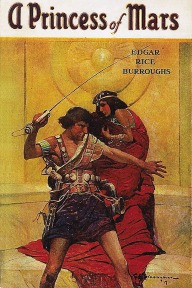
BARELY SUITABLE
October 11: On this day in 1919, the magazine, “Exhibitor’s Trade Review,” published their review of a new film, “The Oakdale Affair.” The title of the review was “See the Bear in “The Oakdale Affair,” and subtitled “Evelyn Greely Breaks In a New Leading Man.”
Screenplay by Wallace C. Clifton and directed by Oscar Apfel, the five reel silent film ran for 25 minutes. Evelyn Greely played Gail Prim and Frank Joyner played the Oskaloosa Kid. The movie was filmed by the World Film Company in Fort Lee, New Jersey. No copy of the film is known to exist, but piecing the script together from various sources, the story went like like this.
Refusing to marry her stepmother's choice, Gail Prim left her life of luxury, after cutting her hair, dressing in her butler's clothes and stealing money and jewels from her father's safe. She spends the night in a barn and introduces herself to the thieves already there as the Oskaloosa Kid, a wanted criminal, and barely escapes their struggle to get her loot. Meanwhile, the real Oskaloosa Kid kills Reginald Paynter and throws Nettie Penning, whom Reginald was trying to seduce, onto the highway. Gail and Arthur Stockbridge, a friendly tramp who helps her, find Nettie and take her to a deserted house, where they meet Gioja, a gypsy, and her performing bear. After Nettie is seized by crooks and returned to her father for a reward, Gail and Arthur are arrested, as suspected killers of the missing Gail. Gail's father stops a mob about to lynch them by confirming her identity, after which Arthur, really an author looking for inspiraion, wins Gail's affections.
The drabble for today, inspired by Edgar Rice Burroughs, is “Barely Suitable.”
BARELY SUITABLE
![]()
Gioja, the gypsy, said, “He’s a real bear. He doesn’t have a suit, just a hat and a tambourine.”
“What tricks does he do?”
“He dances a bit, plays the tambourine, does a summersault, and most importantly, he stays by my side.”
“Is that important?”
“A woman such as myself attracts unwanted attention. The bear takes care of any such problems quickly.”
“He does?”
“Yes, one little bear hug walk that is?
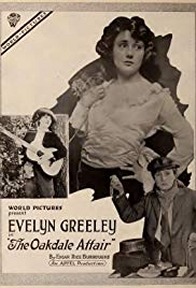
APACHE PRINCESS, MARTIAN PRINCESS
October 12: On this day in 1844, General Charles King was born in Albany, New York. King was the son of Civil War general Rufus King, grandson of Columbia University president Charles King, and great grandson of Rufus King, who was one the signers of the United States Constitution on September 17, 1787, in Philadelphia. He graduated from West Point in 1866 and served in the Army during the Indian Wars under George Crook. He was wounded in the arm and head during the Battle of Sunset Pass forcing his retirement from the regular army as a captain in 1879. During this time he became acquainted with Buffalo Bill Cody. King would later write scripts for several of Cody's silent films. He also served in the Wisconsin National Guard from 1882 until 1897, becoming Adjutant General in 1895.
In 1892 King took over as commandant of the Michigan Military Academy at Orchard Lake. King liked cadet Edgar Rice Burroughs, but at one point he sent a telegram to the ERB's father saying, "Your son deserted Thursday. Letter will follow." An excerpt from the follow-up letter read: “Cadet Burroughs’ offenses have been most serious, but not irretrievably so. He has been reckless; not vicious. He has found friends here including the Commandant, who best knew the boy in the Cavalry squad and on drill, and it is not impossible for him to return and wipe out his past.”
ERB did return and excelled, and the lifetime friendship was cemented.
ERB and King corresponded until King's death in 1933. King was also a literary contemporary of ERB, writing numerous books on the history of the cavalry and Indians out west, including his novel, “An Apache Princess,” published in 1903.
Today’s drabble, “Apache Princess, Martian Princess,” is inspired by Edgar Rice Burroughs and Charles King.
APACHE PRINCESS, MARTIAN PRINCESS
![]()
King replied. “I started that book when you were AWOL back in Michigan. It was published in 1903, long before your Dejah Thoris was even a twinkle in John Carter’s eyes. However, I read the opening to your “Princess” story and noticed the old Indian woman lying dead inside the cave. Seems to me that if any literary ‘borrowing’ has gone on, it was by the student, not the commandant. If so, I forgive you.”
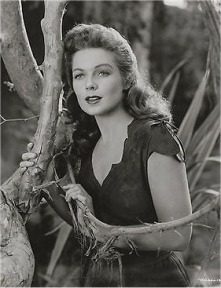
PARTS OF SPEECH
October 13: On this day in 1929, actress Joyce Elaine Mackenzie Hassing was born in Redwood City, California. She used the screen name, Joyce MacKenzie, and was the eleventh actress to play Jane in 1953’s “Tarzan and the She-Devil.” Lex Barker played Tarzan and Raymond Burr played the evil Vargo.
During WWII, Joyce worked as a carpenter’s helper in the shipyards. She was working as a cashier when she was ‘discovered,’ and her first film role was in 1946’s,”Tomorrow is Forever,” with Orson Wells and Claudette Colbert.
Joyce’s career lasted 8 years and about 22 films. Her last film was “Rails Into Laramie,” with John Payne and Dan Duryea. Her last acting appearance that I can find was in a 1961 episode of Perry Mason, “The Case of the Duplicate Daughter.” After leaving Hollywood, she returned to college and got her teacher's degree. In 1976 she was teaching English at Niguel Hills Jr. High School in Laguna Niguel, CA.
In 1975, she reunited with Eve Brent, Louise Lorraine, Buster Crabbe, Jock Mahoney, Johnny Weismuller, and Jim Pierce at the North American Science Fiction Convention in Los Angeles to honor the 100th anniversary of the birth of Tarzan creator Edgar Rice Burroughs. She is currently lives in Dana Point, California.
Today’s drabble, "Parts of Speech" is inspired by Edgar Rice Burroughs and Joyce Elaine Mackenzie Hassing.
PARTS OF SPEECH
![]()
Director Kurt Neumann replied, ”Please, just give it
a rest. Say the words as written. Writers write. Actors act.”
“Grammar matters. The script says, “The chief of the
tribes are angry. That’s wrong. Chief is the subject, not tribes. That
means the verb should be singular – Chief is angry.”
“Are you a English teacher?”
“That’s AN English teacher, and no, I’m not, but I
will be.”

REMATCH
October 14: On this day in 1966, Episode 6 of the first season of “Tarzan” starring Ron Ely debuted on NBC. The episode, “The Three Faces of Death” featured the talented Woody Strode. The writing credit for the episode was assigned to S. J. Loy and appears to be the only screenplay that he or she wrote for anything.
Tarzan agreed to be the champion for a female who should inherit leadership of her tribe, but she is challenged and in the best tradition of “Trial by Combat,’ must engage in three challenges so that she can retain leadership of the tribe. The photo included with the post is of Ron Ely and is taken from theepisode. I tried to do a screen capture of Strode and Ely on screen together, but was never able to manage it.
“Rematch” is today’s drabble and it’s inspired by Edgar Rice Burroughs, Woody Strode, and the Tarzans that he fought.
REMATCH
![]()
“Yes. Who do I fight?”
“The test’s called the “Three Faces of Death. You
have to fight Woody Strode.”
“These seems familiar, I have a strong sense of deja
vu.”
“That’s the test. If you lose, Lanteen will be killed.”
“I understand. Another Tarzan did this three years
ago, it was called “Tarzan’s Three Challenges” and it starred Jock Mahoney.”
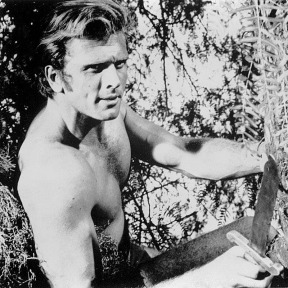
ACT LIKE TARZAN, PAID LIKE CHEETA
October 15: On this day in 2010, Johnny Sheffield, "Boy" in eight Tarzan movies and “Bomba the Jungle Boy” in a dozen thereafter, died in Chula Vista, California. Johnny’s wife reported that he fell from a ladder while pruning a palm tree. He appeared uninjured, but died four hours later.
Born john Mathew Sheffield Cassan in Pasadena ,California, Sheffield made few films besides the Tarzan and Bomba films, for which he was best known. He played Knute Rockne as a child in the film, “Knute Rockne, All- American,” and appeared in “Babes in Arms,” with Mickey Rooney and Judy Garland in 1939.
After his last film role in, Sheffield enrolled in college and obtained a business degree from UCLA. He worked in farming, real estate and construction. In his later years, he wrote articles about his career and sold video copies of his unsold television series pilot, “Bantu, the Zebra Boy.”
You can watch the episode on YouTube at:
Erbzine has a wealth of information about Sheffield. The following link will guide you.
ACT LIKE TARZAN, PAID LIKE CHEETA
![]()
“I understand that. I’ll dress like Boy and look like Boy, but I have to act like Tarzan.”
“That’s the general idea. We’re gonna make three of these babies a year, so try to get things right the first time.”
“Understood, but if I act like Tarzan does that mean I get paid like Johnny Weissmuller?”
“Low budget, remember. Just be happy that you aren’t getting paid like Cheeta. There’s a bowl of fruit in your room.”
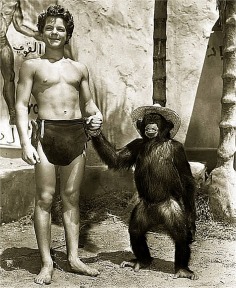
![]()
See
Days 16-31 at ERBzine 7160a
![]()
OCTOBER II ILLUSTRATIONS COLLAGE
![]()
